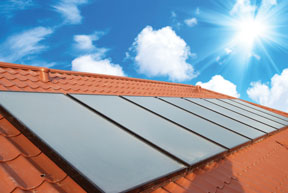| << Back |
Going Green: Making the Most of the Sun’s Rays – A Solar Story for Nevada
By Lisha Ross
With approximately 320 days of sunshine per year, there’s no place on Earth that a solar energy system will produce more electricity than Southern Nevada. Perhaps that’s why these days just about everybody is pining to collect the sun’s rays. In 2008, PulteGroup Inc.’s Villa Triesta became the city’s first community to offer a roof-integrated solar power system as a standard option, and in March of this year Meritage Homes unveiled an eco-friendly development complete with solar systems to offset electricity, water heating and air conditioning.
Of course, this is all good news for “green” folks in the market for a new home, but what of home owners who want to join the movement in their existing abodes? Well, there’s even more good news! Options for incorporating solar power abound and the benefits are many. Aside from doing our part to reduce our dependence on non-renewable resources, we might just be able to save a few bucks in the long term with some sound financial decisions.
Systems Big and Small
When researching solar power, you’re likely to encounter a barrage of foreign-sounding words and phrases. The two most applicable for residential use are solar photovoltaic (PV) systems and solar thermal systems. PV systems are comprised of approximately 20 panels that convert the sun’s energy into electricity in order to offset a home’s total electrical usage. Solar thermal systems convert sunlight into heat that can furnish your home’s hot water needs.
No matter if you go totally PV or opt for a smaller scale thermal system, which requires fewer roof panels, the obvious financial benefit is lower bills. To put the savings in perspective, water heating accounts for about a quarter of total energy usage in a single family home. By some estimates, switching to a thermal system can potentially help owners save between 50% and 85% on their utility bills. It’s trickier to estimate savings from a PV system, as it depends on the size of your system and several other factors. Some estimates suggest it is around $500-$900 per year, but with an all encompassing system, you may never see a power bill again.
Nickels and Dimes
Potential savings notwithstanding, the two most common questions solar sales people hear are: How much does it cost? and Can I get a rebate? Unfortunately, these figures often stop potential customers in their tracks. It costs about $15,000 to $25,000 for an adequate PV system and anywhere between $2000 and $8000 for a solar thermal system, again depending on the size of your home and your family’s needs. Only a licensed contractor can provide a proper estimate after a careful evaluation of your home and electrical usage. While the state legislature and other entities are working hard to make solar more affordable to all, there are currently several incentive programs that can take a load off the initial expense. Here are just a few:
Federal Tax Credit: Until December 31, 2016, homeowners and businesses that install qualified PV systems and/or solar thermal systems are eligible to receive 30% of the installation cost in tax credits.
NV Energy: Through Net-Metering, NV Energy offers credits in exchange for energy your system produces that you do not use. As part of their Solar Hot Water Incentive Program, they also offer rebates of up to 50% of the installation cost of a solar thermal system up to $1500.
Southwest Gas: Through Southwest Gas’ Solar Water Program, they offer rebates based on the amount of therms (heat energy) expected to be generated by the system.
Nevada State: Nevada offers property tax incentives where any value added to the home by a qualified renewable energy system will be subtracted from the assessed value for property tax purposes.
Be sure to check out the eligibility requirements for each program. Most, if not all require you submit an application prior to installation. For more detailed information on these programs as well as financing, visit www.dsireusa.org.
The Final Figures
Yes, even with incentives, the initial expense packs a pretty hard punch. For many, the concern is that they will sell their home before they see a return, but that’s not usually the case. Randell Hynes, founder of Solar Forces, co-founder of Nevada Solar Authority, Ltd. and lobbyist for change in Nevada’s energy market, argues that it helps to understand how this investment pays for itself by increasing the value of your home. “For example,” he explains, “in the Nevada market, the net cost of a 20 solar panel PV system is $14,500 after the federal tax credit. By considering the annual value of the electricity that the system will generate over its 25-year life, the initial appraised value is nearly $27,000…and it will retain an appraised value of more than the [original] net cost for over 20 years.” With this added value, he continues, homeowners can “recover the net cost of the installation, or perhaps more, by selling the projected value of ‘not paying the utility’ to the new owner.”
Still have questions? There is no shortage of local contractors anxious to talk to you about your options, and a listing of them can be found at www.nevadasolarenergy.org. When considering any form of solar system, always remember: you’re not just investing in your own future; you’re investing in the future of the planet!








